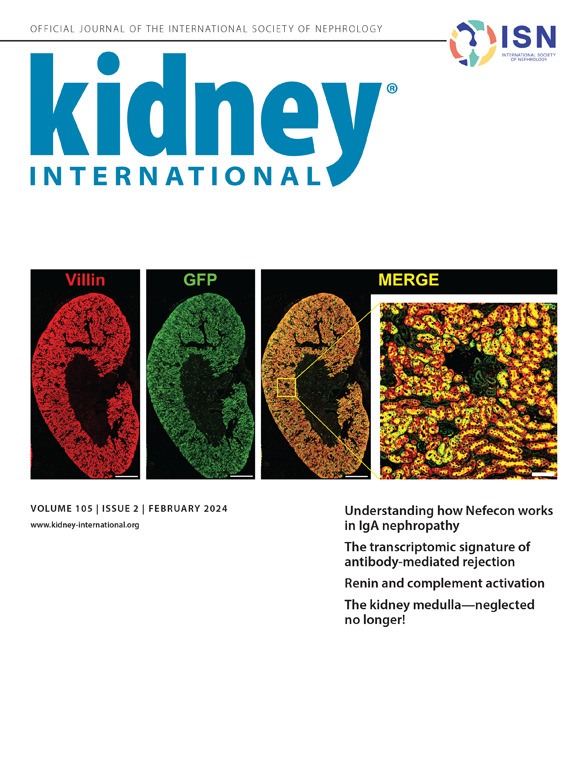A randomized controlled trial of intravenous immunoglobulin vs standard of care for the treatment of chronic active antibody-mediated rejection in kidney transplant recipients.
IF 12.6
1区 医学
Q1 UROLOGY & NEPHROLOGY
引用次数: 0
Abstract
INTRODUCTION Chronic active antibody-mediated rejection (AMR) is the leading cause of death-censored kidney allograft loss, with no proven treatments. While intravenous immunoglobulin (IVIG) has been used in certain cases, its efficacy is unknown. METHODS In this open-label multicenter randomized controlled trial (VIPAR), participants with biopsy-proven chronic active AMR, were assigned to six doses (1g/kg/month) of IVIG or no-IVIG. The primary endpoint was the difference in slopes of the chronic allograft damage index (CADI) scores between groups, across four allograft biopsies (baseline, three, six and 12-months). Secondary outcomes, assessed at baseline, three, six and 12-months, included change in estimated glomerular filtration rate (eGFR), change in donor specific anti-HLA antibodies (DSA), allograft and patient survival, and change in intra-graft mRNA expression. RESULTS Fifteen participants were randomized to each arm. Their median age was 54.3 years, 22 were male and mean eGFR was 43.3 ml/min/1.73m2. Participants in the no-IVIg group experienced a significant increase in mean CADI (+0.28/month, 95% confidence interval 0.14 to 0.41), while the IVIG group did not (-0.004/month, - 0.13 to 0.12). Over two years, eGFR significantly declined more rapidly in the no-IVIG group (-1.1 ml/min/month, -1.5 to -0.7 ml/min/month) than the IVIG group (-0.4 ml/min/month, - 0.8 to 0.03 ml/min/month). Differences in patient and allograft survival were not evident by 12 months. Intra-graft expression of 59 genes (mostly B-cell related) reduced with IVIG relative to no-IVIG. CONCLUSION IVIG therapy was associated with stabilization in allograft histology and eGFR in kidney transplant recipients with chronic active AMR.静脉注射免疫球蛋白与标准护理治疗肾移植受者慢性主动抗体介导的排斥反应的随机对照试验
慢性主动抗体介导的排斥反应(AMR)是导致死亡的主要原因,目前尚无有效的治疗方法。虽然静脉注射免疫球蛋白(IVIG)已在某些情况下使用,其疗效尚不清楚。方法在这项开放标签多中心随机对照试验(VIPAR)中,活检证实的慢性活动性AMR患者被分配到6个剂量(1g/kg/月)的IVIG或不使用IVIG。主要终点是四组同种异体移植活检(基线、3个月、6个月和12个月)中慢性同种异体移植损伤指数(CADI)评分斜率的差异。在基线、3个月、6个月和12个月时评估的次要结果包括肾小球滤过率(eGFR)的变化、供体特异性抗hla抗体(DSA)的变化、同种异体移植物和患者生存率的变化以及移植物内mRNA表达的变化。结果15名参与者被随机分配到每组。他们的中位年龄为54.3岁,22名男性,平均eGFR为43.3 ml/min/1.73m2。无IVIG组的参与者平均CADI显著增加(+0.28/月,95%可信区间0.14至0.41),而IVIG组没有(-0.004/月,- 0.13至0.12)。两年后,与IVIG组(-0.4 ml/min/month, - 0.8 ~ 0.03 ml/min/month)相比,无IVIG组eGFR下降明显更快(-1.1 ml/min/month, -1.5 ~ -0.7 ml/min/month)。12个月时,患者和同种异体移植的存活率差异不明显。移植体内59个基因(主要是b细胞相关)的表达随着IVIG的增加而降低。结论ivig治疗与慢性活动性AMR肾移植受者同种异体移植物组织学和eGFR的稳定有关。
本文章由计算机程序翻译,如有差异,请以英文原文为准。
求助全文
约1分钟内获得全文
求助全文
来源期刊

Kidney international
医学-泌尿学与肾脏学
CiteScore
23.30
自引率
3.10%
发文量
490
审稿时长
3-6 weeks
期刊介绍:
Kidney International (KI), the official journal of the International Society of Nephrology, is led by Dr. Pierre Ronco (Paris, France) and stands as one of nephrology's most cited and esteemed publications worldwide.
KI provides exceptional benefits for both readers and authors, featuring highly cited original articles, focused reviews, cutting-edge imaging techniques, and lively discussions on controversial topics.
The journal is dedicated to kidney research, serving researchers, clinical investigators, and practicing nephrologists.
 求助内容:
求助内容: 应助结果提醒方式:
应助结果提醒方式:


